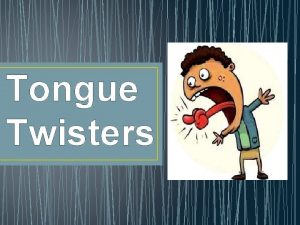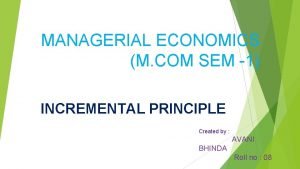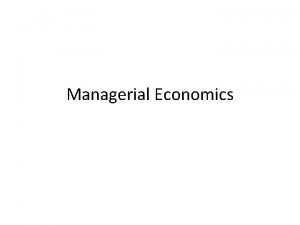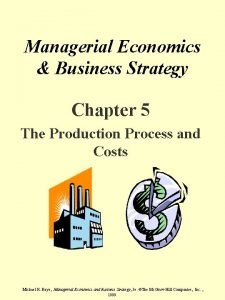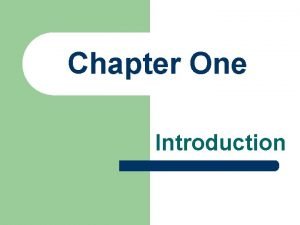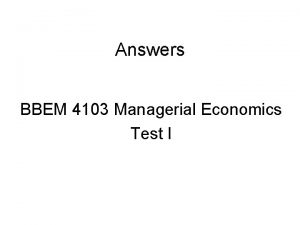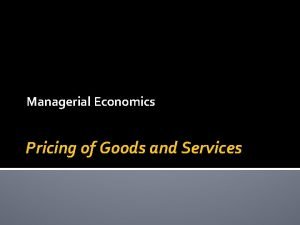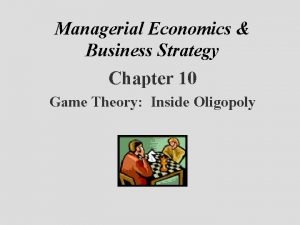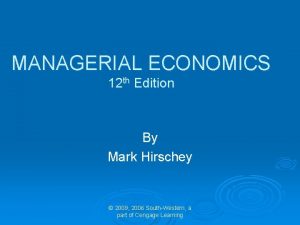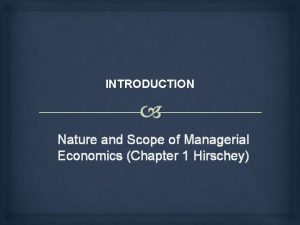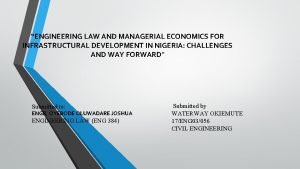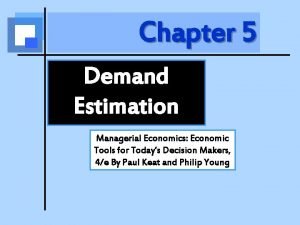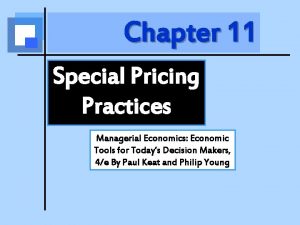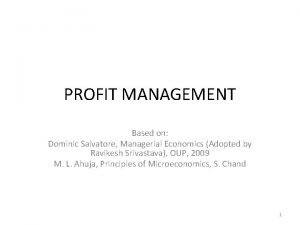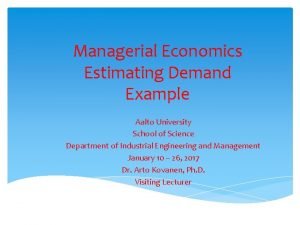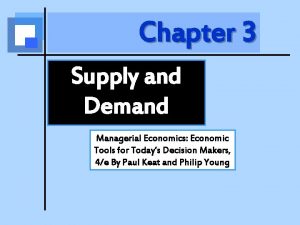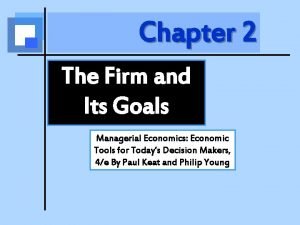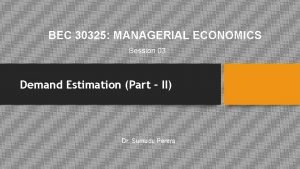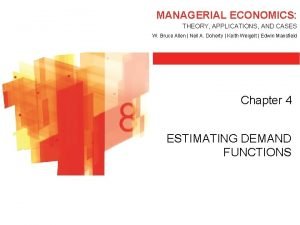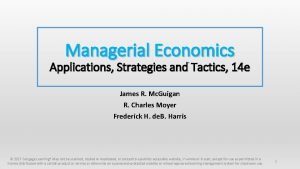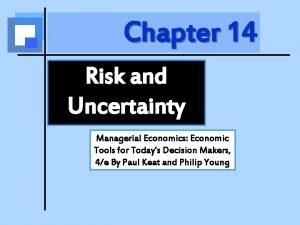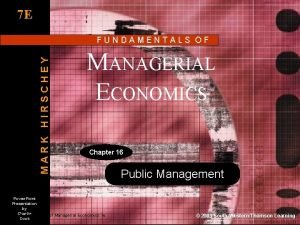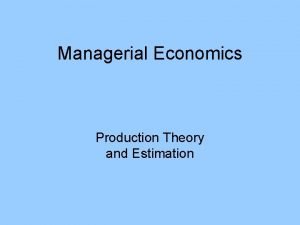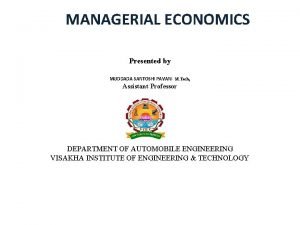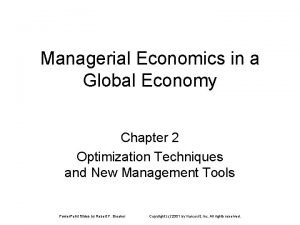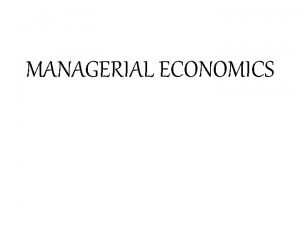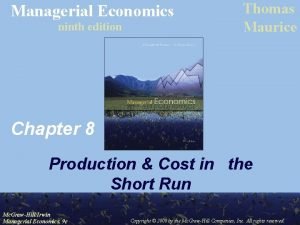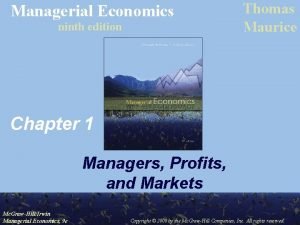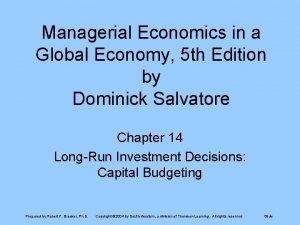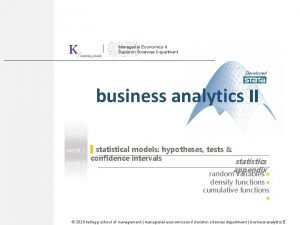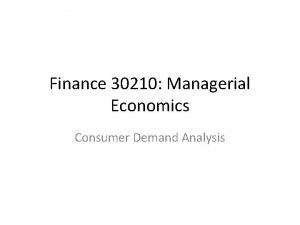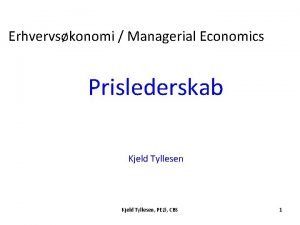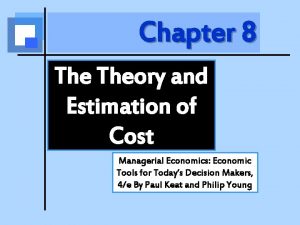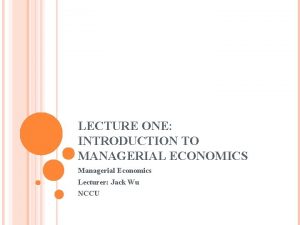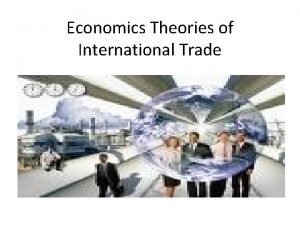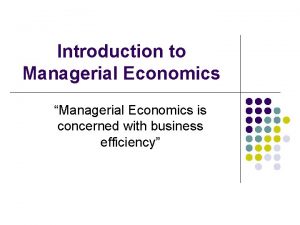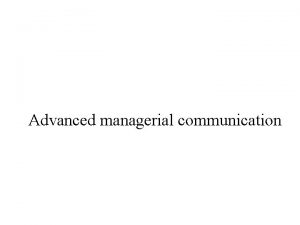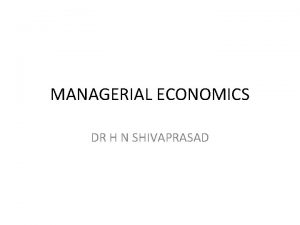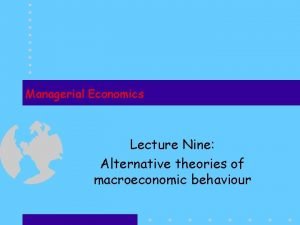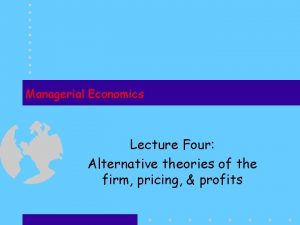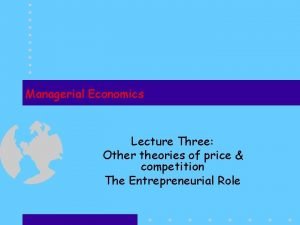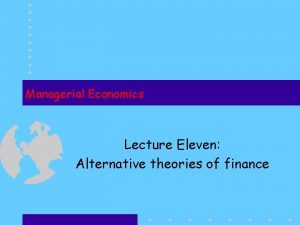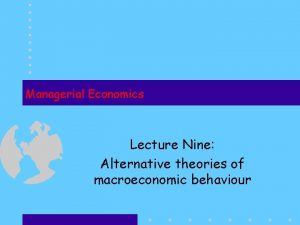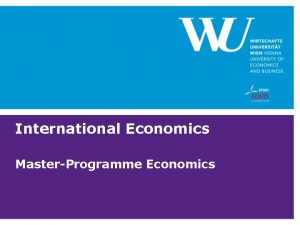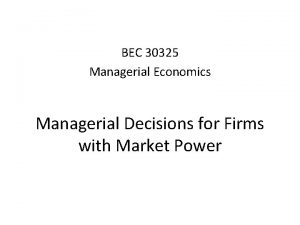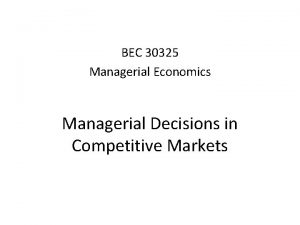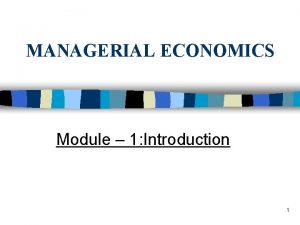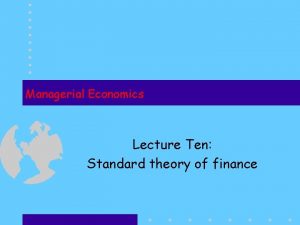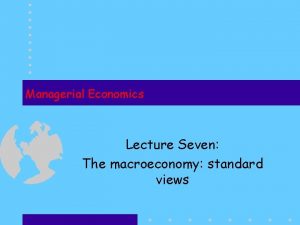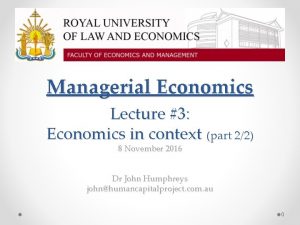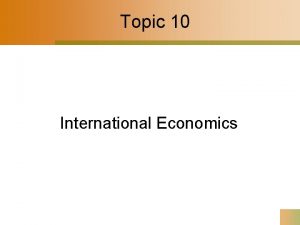Managerial Economics Lecture Twelve Standard theories of international









































- Slides: 41

Managerial Economics Lecture Twelve: Standard theories of international competition Theory & Reality…

An undisputed truth? • Belief in superiority of free trade near universal amongst economists • Basic proposition put by Samuelson & Nordhaus: – “Simply put, trade promotes specialization, and specialization increases productivity. ” (297) • Argument essentially unchanged since Ricardo in 1817: – Trade lets countries specialise in producing goods in which they have a comparative advantage: • Not absolute productivity relative to other country, but • Comparative productivity with respect to own industries

Free Trade and Specialisation • Ricardo’s “Comparative Advantage” – Took case Mercantilists argued would mean rival (Portugal) would “defeat” England in open trade • Portugal assumed better than England at producing everything • Argued that England would still benefit from free trade – The Model:

Free Trade and Specialisation • Two countries producing 2 commodities • Assume Portugal – Absolutely more efficient at producing both wine and cloth – Relatively more efficient at producing wine than cloth • More of both wine and cloth produced if – England specialises in cloth – Portugal specialises in wine • Countries trade surpluses and increase consumption of both goods in both countries

Comparative Advantage • Portugal (per 1000 men) – 90 men to produce x units of cloth – 80 men to produce y units of wine – can produce • 11. 1 units of cloth; or • 12. 5 units of wine; or • any “straight line” combination of the two • England (per 1000 men) – 100 men to produce x units of cloth – 120 men to produce y units of wine – can produce 10 units cloth, 8. 5 units of wine, or any linear combination:

Comparative Advantage • So with no trade: – Portugal Max. 11. 1 cloth, or 12. 5 wine – England Max 10 cloth, or 8 1/3 wine • Trade – Portugal 12. 5 wine, England 10 cloth – Exchange surpluses, total output greater • Putting Ricardo’s arguments in a diagram…

Wine output with trade Wine Comparative Advantage Trade: England produces only Cloth, Portugal only Wine; output higher Wine output without trade gla nd Cloth output with trade l ga rtu Po En Cloth output without trade

Comparative Advantage • “Under a system of perfectly free commerce, each country naturally devotes its capital and labour to such employments as are most beneficial to each. This pursuit of individual advantage is admirably connected with the universal good of the whole. By stimulating industry, by regarding ingenuity, and by using most efficaciously the peculiar powers bestowed by nature, it distributes labour most effectively and most economically. ” (Ricardo 1817) • Clever logical argument aided repeal of Corn Laws • Identical to modern economic belief – (Ricardo’s model is economics’ “one big trick”) • Show increase in output by reallocating static resources • But behind Ricardo’s rhetoric, a Realpolitik…

Ricardo’s Realpolitik • “It has been my endeavour to shew throughout this work, that the rate of profits can never be increased but by a fall in wages, and that there can be no permanent fall of wages but in consequence of a fall of the necessaries on which wages are expended. If, therefore, by the extension of foreign trade, or by improvements in machinery, the food and necessaries of the labourer can be brought to market at a reduced price, profits will rise. ” (Ricardo 1817) • Ricardo’s real interest not efficiency, but – shift income from landlords to capitalists (workers irrelevant to Ricardo) – Real objective to increase rate of investment

Modern Comparative Advantage • If price of wheat falls – Rents fall – Money wages fall (cheaper wheat) while real wages remain constant – Increased profits – Greater accumulation – Objective: promote growth by redistributing income • Neoclassical Heckschler-Ohlin-Samuelson trade model – Exclusively static – Therefore ignores income distribution & hence growth issue – Basic theory by Heckscher, Ohlin, Samuelson, Vanek – Best shown using “Edgeworth Box” analysis:

Modern Comparative Advantage pr e ic tio ra consumption production PCs (“capital intensive”) Consumption outside PPC Shoes (“labor intensive”) e ad “Social indifference curves” PCs (“capital intensive”) Tr Shoes (“labor intensive”) “Production possibility curve” Price ratio

Modern Comparative Advantage • Fervently believed in by most economists: – “The principle of comparative advantage holds that each country will benefit if it specializes in the production and export of those goods that it can produce at relatively low cost. Conversely, each country will benefit if it imports those goods which it produces at relatively high cost. This simple principle provides the unshakable basis for international trade. ” (Samuelson 300) – “Notwithstanding its limitations, theory of comparative advantage is one of the deepest truths in all of economics. Nations that disregard comparative advantage pay a heavy price in terms of their living standards and economic growth. ” (308)

Modern Comparative Advantage • But model makes some extreme assumptions – Full employment of all factors of production • Otherwise countries would not be on “Production Possibility Frontier” – Costless mobility of factors of production between sectors • Labour and capital can be moved from computer production to shoe production without loss of productivity – Immobility of factors between countries • Otherwise gains in one country would accrue to factor owners in another country – Identical technology used in production everywhere • Initially, even Samuelson admitted qualms about them:

Modern Comparative Advantage • “The Ohlin analysis explains much; but there is much that it fails to explain; and if adhered to inflexibly, there is much that it can obscure. Its two central tenets are open to grave doubt: • Is it reasonable and useful to set up the hypothesis that production functions are the same the world over? Is it possible to find reasonably homogeneous and commensurable factors of production in diverse parts of the world, so that relative proportions can be defined and compared? • Certainly no strong affirmative answers to these two questions can be given—as Ohlin himself has pointed out in a number of places. The laws of nature may be the same “everywhere, ” but the laws of nature and the economically relevant production function relating maximum output obtainable from specified concrete inputs are two quite different things…” (Samuelson 1948 “International Trade And The Equalisation Of Factor Prices”, Economic Journal Vol. 63) • So maybe the “unshakable basis” isn’t all that sound… • Let’s consider the data…

Modern Comparative Advantage • Model makes several empirical predictions: – Direction of trade determined by relative factor abundance • Country with relative abundance of capital should export capital intensive goods • Country with relative abundance of labour should export labour intensive goods – Incomes and trade • Trade should cause “factor price equalization”: wages and return on capital should tend to equality throughout world under freer trade – Trade surpluses should be counterproductive • Trade surplus should only lead to inflation since economies in full employment – Free Trade best route for development • Exploits country’s comparative advantage

Direction of Trade: “Leontief’s Paradox” • Wassily Leontief (father of input-output analysis) analysed US trade flows in 1953 – Found that US exports were labour intensive & imports capital intensive • Exports capital component $14 K per man-year • Imports capital component $18 K per man-year • Reverse of Heckscher-Ohlin-Samuelson prediction! – Composite “export” & “import” commodities defined – Composite “labour” and “capital” factors – Later generalisations (more disaggregated commodities & factors) generally reached same result: • Pattern of trade opposite to predictions of HOS theory – Some recent results find theory valid but only if another result of theory dropped: factor price equalization”…

Direction of Trade: “Leontief’s Paradox” • “The Heckscher-Ohlin-Vanek (HOV) model of factor service trade is a mainstay of international economics. Empirically, though, it is a flop…” (Davis et al. AER 1997) • “Starting with the classic "paradox" of Wassily W. Leontief (1953) … the Heckscher-Ohlin (HO) model has consistently performed poorly in empirical tests. This led Trefler (1993) to aver that "its predictions are always rejected empirically. “ • In spite of these empirical failures, the Heckscher-Ohlin model remains ubiquitous in theory, empirics, and policy analysis. In part, this reflects an a priori belief that the model embodies fundamental general equilibrium links between primary factors and production structure that we believe will be part of any fully articulated and empirically relevant theory…” (421)

Direction of Trade: “Leontief’s Paradox” • Davis et al. test theory in “regions that exhibit factor price equalization (FPE)” – Find that “the theory may do quite well as a simple description of the data. ” • Choi & Krishna 2004 “The Factor Content of Bilateral Trade: An Empirical Test” Journal of Political Economy – Nearly all the tests of the factor content predictions of the model … have assumed full factor price equalization (FPE) across countries and identical homothetic preferences across countries” – Their paper “relies neither on FPE nor on any restrictions on preferences” • since “even casual evidence suggests that full FPE does not hold … and that preferences are nonhomothetic and vary substantially with income level…”

“Factor Price Equalization” • FPE: prediction that trade would equalise wages & profits worldwide… – Clearly false: “even casual evidence suggests that full FPE does not hold” (Choi & Krishna) • But if FPE dropped & HOS “tested”… – Results could simply mean “countries where labour is cheap export labour intensive goods…” etc. • Trade driven by absolute advantage rather than comparative • Essential aspect of comparative advantage is realignment of internal prices & incomes to global prices & incomes

Trade surpluses • Theory says trade surplus futile because – With fixed exchange rates causes increase in money supply • drives up prices • Domestic inflation makes commodities more expensive on world market • Restores equilibrium – With floating exchange rate • Causes currency appreciation • Restores equilibrium • What is the empirical record? – According to Samuelson, it’s conclusive:

Trade surpluses • “while economic protection may raise employment, it does not constitute an effective program to pursue high employment, efficiency, and stable prices…. • This lesson was amply demonstrated in the 1990 s. From 1991 to 1999, the United States created 16 million net new jobs while maintaining open markets and low tariffs; its trade deficit increased sharply during this period. By contrast … Japan had rising unemployment with a growing trade surplus. ” (Samuelson: 316) • Really? Here’s the data (© WTO) – http: //stat. wto. org • current (nominal) prices

Trade surpluses • US trade deficit began 1968 – Accelerated in 1990 s • Japan surplus began 1981 – Constant across 1990 s – Falling in real terms: • Japan’s stagnation: 1989 “Bubble Economy” collapse • US boom: Internet Bubble • Trade performances irrelevant

Free trade and development? • Development, Trade, And The WTO – “Today, trade policy is at the forefront of the development agenda, and it is a critical element of any strategy to fight poverty. This renewed interest in trade liberalization does not come from dogma but instead is based on a careful assessment of development experience over the last 50 years. ” Hoekman, Mattoo, and English, (Eds. ), (xi) – “Trade liberalization may have adverse consequences for some—including some poor people—that should be avoided or ameliorated to the greatest extent possible. My fundamental belief, however, is that trade liberalization aids growth, which, in turn, aids poverty alleviation. ” Alan Winters, “Trade Policies for Poverty Alleviation” (28)

Free trade and development? • Economists & formal bodies equally confident: – “IMF (1997, 84): “Policies toward foreign trade are among the more important factors promoting economic growth and convergence in developing countries. "” – “OECD (1998, 36) states: “More open and outwardoriented economies consistently outperform countries with restrictive trade and [foreign] investment regimes. ”” (1) • Rodriguez & Rodrik (2000): – “We find little evidence that open trade policies—in the sense of lower tariff and non-tariff barriers to trade—are significantly associated with economic growth. ” (Abstract)

Free trade and development? • Correlation between trade barriers & growth: “the slope of the relationship is only slightly negative and nowhere near statistical significance” (2)

Free trade and development? • Recent studies use more complicated indicators of “openness to trade” imply stronger relationship; but – “In many cases, the indicators of "openness" used by researchers are problematic as measures of trade barriers or are highly correlated with other sources of poor economic performance. – In other cases, the empirical strategies used to ascertain the link between trade policy and growth have serious shortcomings, the removal of which results in significantly weaker findings. ” (4) – “… the nature of the relationship between trade policy and economic growth remains very much an open question. The issue is far from having been settled on empirical grounds. We are in fact skeptical that there is a general, unambiguous relationship between trade openness and growth…” (6)

Free trade and development? • HOS/Ricardian comparative advantage static – “Optimal tariff” is zero • R&R present “dynamic” model – Output=Agriculture + Manufacturing – Agriculture productivity constant – Manufacturing productivity • Rises over time • Reflects “learning by doing” – The higher output gets, the more learning occurs – With otherwise neoclassical assumptions • Wage=marginal product • Equilibrium across both sectors – Small tariff increases manufacturing sector compared to agriculture

Free trade and development? • Causes greater growth of manufacturing productivity – But also devotes some of today’s inputs against relative productivity today – “Hence the tariff exerts two contradictory effects on growth. By pulling resources into the manufacturing sector, it enlarges the scope for dynamic scale benefits, thereby increasing growth. But it also imposes a static efficiency loss, the cost of which rises over time as the manufacturing sector becomes larger. ” (12) • Working from neoclassical assumptions and “stylised fact” that growth in manufacturing productivity exceeds growth in agricultural – Model suggests optimal tariff > 0 initially and then should be cut as development occurs – Thus even neoclassical theory shows…

Free trade and development? • “there is no determinate theoretical link between trade protection and growth once real-world phenomena such as learning, technological change, and market imperfections (here captured by a learning-by-doing externality) are taken into account. ” (13) • R&R critique recent papers (e. g. Dollar 1992) – Many technical aspects to critique – Main practical one: “Law of one price” & “Purchasingpower parity” • Dollar assumes trade barriers only source of nominal price differences for same good in different countries – “Law of one price” & “Purchasing-power parity” • But this “Law” doesn’t hold empirically:

Free trade and development? • “Rogoff (1996, 648) writes of the "startling empirical failure of the law of one price. " … "commodities where the deviations from the law of one price damp out very quickly are the exception rather than the rule" (Rogoff 1996, 650). • Rogoff (1996, 647) concludes … that the speed of convergence to purchasing-power parity (PPP) is extremely slow, of the order of roughly 15 percent per year. – At this speed of convergence, averages constructed over a time horizon of 10 years (the horizon used in Dollar's paper) would exhibit substantial divergence from PPP in the presence of nominal shocks. ” (18)

Free trade and development? • Result: Dollar’s index of trade barriers highly distorted: – “The ten least distorted countries by this measure include not only Hong Kong, Thailand, Malta, but also Sri Lanka, Bangladesh, Mexico, South Africa, Nepal, Pakistan and Syria! – Burma's rating (90) equals that of the United States. – Taiwan (116) is judged more distorted than Argentina (113). ” (20) • Similar problems in other influential “trade promotes development” paper Sachs and Warner (1995) – Proxies for trade protection closely related to other issues that may be more important than trade policy:

Free trade and development? • “Indeed, of the 48 economies ranked as closed according to the BMP criteria, 40 had one or more of the following characteristics: – average inflation over 1975 -1990 higher than 10 percent, – debt to GNP ratio in 1985 greater than 125 percent, – a terms-of-trade decline of more than 20 percent, – an institutional quality index less than 5 (on a scale of 1 to 10), or – involvement in a war. • In general, strong correlation results for trade openness & growth “arise either from obvious mis-specification or from the use of measures of openness that are proxies for other policy or institutional variables that have an independent detrimental effect on growth. ” (59)

Free trade and development? • “The tendency to greatly overstate the systematic evidence in favor of trade openness had a substantial influence on policy around the world. • Our concern is that the priority afforded to trade policy has generated expectations that are unlikely to be met, and it may have crowded out other institutional reforms with potentially greater payoffs… • The effects of trade liberalization may be on balance beneficial … the evidence provides no strong reason to dispute this. • What we dispute is the view, increasingly common, that integration into the world economy is such a potent force for economic growth that it can effectively substitute for a development strategy. ” (62 -63)

Free trade and development? • R&R make one interesting positive observation: – “Recent research … has already shed new light on the relationship between trade and firm performance… – these papers … find little evidence that firms derive technological or other benefits from exporting per se; – the more common pattern is that efficient producers tend to self-select into export markets. – In other words, causality seems to go from productivity to exports, not vice versa…” (62) • i. e. , successful innovators end up exporting • Implies Schumpeterian approach to trade:

“Schumpeterian” Trade Theory… • Schumpeterian conjecture – Trade mainly in innovated products • 85% of world trade in manufactures, only 15% is agriculture/raw materials • Japan’s MITI calculates products invented before 1950 constituted < 20% of sales in 1990 – Exports non-domestic avenue for entrepreneurial products • Not constrained by local demand/finance – Surplus means rest of world funds part of domestic entrepreneurial activity • Potential for more growth • Could be maintained indefinitely so long as maintain entrepreneurial edge

Trade and growth in general? • Overall message – Conventional (neoclassical) theory argues getting prices “right” is the “one-size-fits-all” economic policy – Careful analysis of the data doesn’t support this conjecture: many other factors appear to matter: • “There are, in fact, reasons to be skeptical about the existence of a general, unambiguous relationship between trade openness and growth. The relationship is likely to be a contingent one, dependent on a host of country and external characteristics. The fact that practically all of today’s advanced countries embarked on their growth behind tariff barriers and reduced protection only subsequently surely offers a clue of sorts. ” (Rodrik 2002, “Trade Policy Reform as Institutional Reform” Development, Trade, And The WTO: A Handbook, Handbook p. 9)

Trade and growth in general? • “One can cite other instances of heterodox trade reforms that proved successful because they suited existing political and institutional realities. • Korea’s outward orientation during the 1960 s … was achieved not through import liberalization (of which there was little), but through export subsidization (of which there was a lot). – … now prohibited under existing WTO rules on subsidies. • … China’s two-track reform strategy … which maintained nonmarket institutional forms while aligning incentives correctly at the margin, has been wildly successful. • These are cases in which imaginative experimentation with institutional reform has had, in all likelihood, greater payoffs than the wholesale transplantation of institutions from advanced industrial countries would have had. ” (Rodrik 2002: 8)

Whatever happened to…? • Trade theory assumptions seriously at odds with real world – Theory: Factors of production “immobile between countries, perfectly mobile within” • Reality: capital (both financial & physical) highly mobile • Enormous international financial capital flows • Large percentage of “Exports” & “Imports” actually transfers of components between branches of one firm across national borders: “intrafirm trade” – “In 1994, … intrafirm trade … accounted for more than one third of U. S. exports of goods and for more than two fifths of U. S. imports of goods. ” (Zeile 1997, "U. S. Intrafirm Trade in Goods", Survey Of Current Business, Vol 75: 52– 61)

Whatever happened to…? • Intrafirm trade breaches income & welfare aspects of theory – Comparative advantage • income from trade accrues to factors in country • Relatively abundant factor benefits (workers in 3 rd world) – Intrafirm transfers • Capital income sometimes partly captured locally (joint ventures, “asset transfer rules” [common in China]); but • Often profits remitted to “home” (1 st world) country from “host” (3 rd world) country – Transfer of production done to take advantage of low wages, different pollution rules, etc. – May cause rise in wages but depends on • Unemployment levels • Institutional factors (export processing zone labour laws, unions, etc. )

Whatever happened to…? – Theory: Trade balanced • Value of imports=value of exports • Exchange rates adjust to maintain equilibrium • Reality: Most countries have sustained trade pattern for decades—surplus (Japan, Germany…); deficit (USA, Australia) • Exchange rates haven’t adjusted to achieve trade equilibrium – 99% of world currency trade speculative, not to support exports/imports • Capital (finance) flows to counterbalance trade imbalances substantial – Often speculative capital & major cause of currency valuations (including, e. g. , 500% devaluation of Indonesian rupiah in 1 week in late 1990 s)

Trade or innovation? • Conjecture: policies that promote innovation may be more important than policies that promote “level playing field” • Next week: Porter’s management-oriented theory of competitive advantage
 Examples of tongue twisters
Examples of tongue twisters High twelve international
High twelve international Oikonomikos kahulugan
Oikonomikos kahulugan What is incremental concept
What is incremental concept Managerial economics:
Managerial economics: Demand estimation in managerial economics pdf
Demand estimation in managerial economics pdf Managerial economics chapter 1
Managerial economics chapter 1 Ecomics
Ecomics Managerial economics meaning and definition
Managerial economics meaning and definition Methods of cost estimation in managerial economics
Methods of cost estimation in managerial economics Contribution concept in managerial economics
Contribution concept in managerial economics Managerial economics questions and answers
Managerial economics questions and answers Pricing methods in managerial economics
Pricing methods in managerial economics Game theory in managerial economics
Game theory in managerial economics Managerial economics 12th edition mark hirschey
Managerial economics 12th edition mark hirschey What is discounting principle
What is discounting principle Managerial economics nature and scope
Managerial economics nature and scope How managerial economics is useful to engineers
How managerial economics is useful to engineers Regression analysis in managerial economics
Regression analysis in managerial economics Pricing practices in managerial economics
Pricing practices in managerial economics Profit management in managerial economics
Profit management in managerial economics Example of managerial economics
Example of managerial economics Supply analysis in managerial economics
Supply analysis in managerial economics The firm and its goals
The firm and its goals Demand estimation in managerial economics
Demand estimation in managerial economics Managerial economics: theory, applications, and cases
Managerial economics: theory, applications, and cases Managerial economics applications strategy and tactics
Managerial economics applications strategy and tactics Certainty equivalent
Certainty equivalent Fundamentals of managerial economics
Fundamentals of managerial economics Empirical production function managerial economics
Empirical production function managerial economics Managerial economics
Managerial economics Managerial economics is called as
Managerial economics is called as Managerial economics
Managerial economics Managerial economics
Managerial economics Managerial economics
Managerial economics Managerial economics in a global economy
Managerial economics in a global economy Managerial economics and decision sciences
Managerial economics and decision sciences Managerial economics demand analysis
Managerial economics demand analysis Prislederskab modellen
Prislederskab modellen Estimation of cost function in managerial economics
Estimation of cost function in managerial economics 01:640:244 lecture notes - lecture 15: plat, idah, farad
01:640:244 lecture notes - lecture 15: plat, idah, farad Principles of economics powerpoint lecture slides
Principles of economics powerpoint lecture slides
